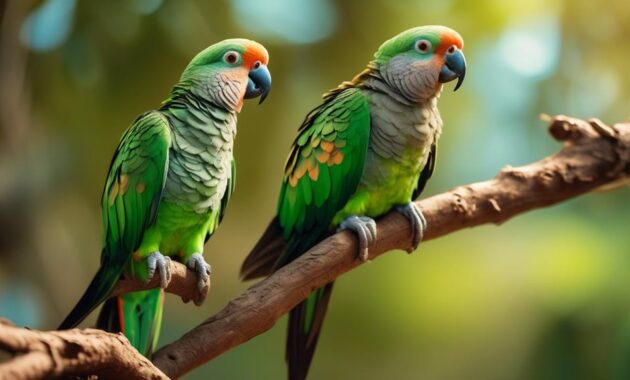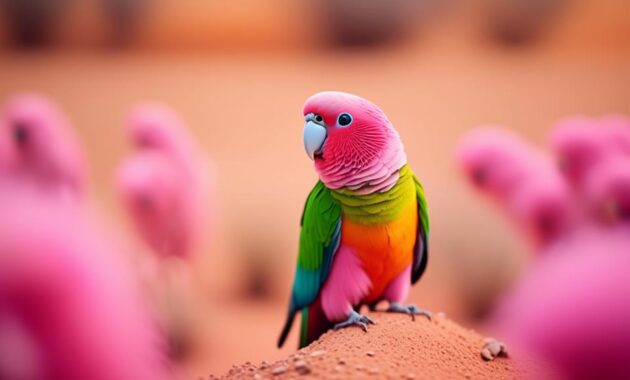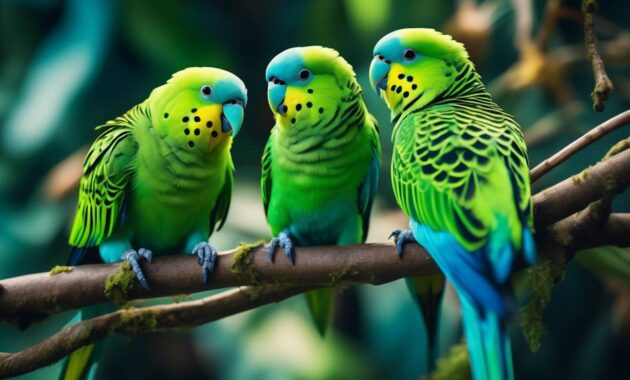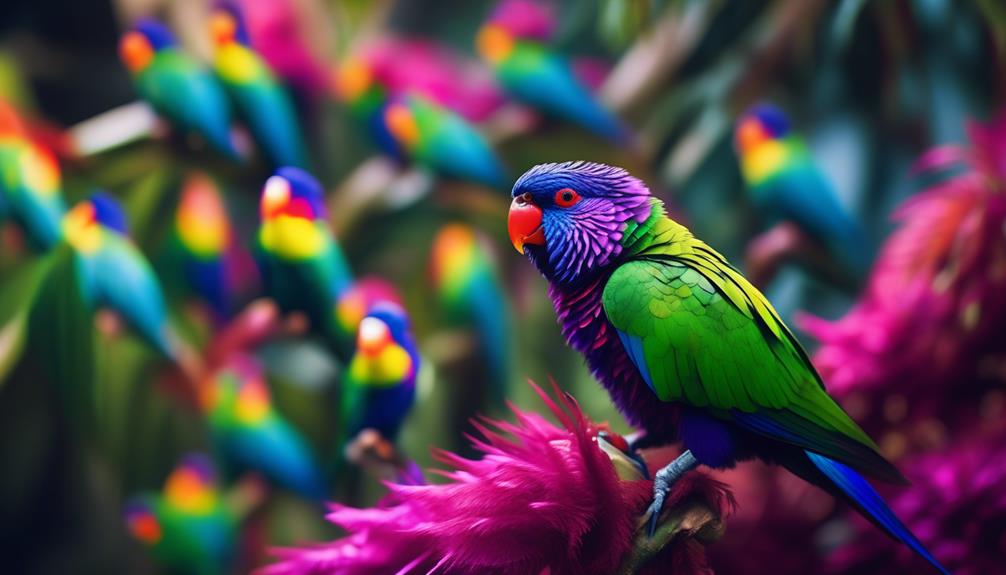
Are you ready to dive into the colorful world of the Purple Crowned Lorikeet?
This vibrant and playful bird is like a burst of joy, with its striking hues and energetic nature.
But there's more to this avian gem than meets the eye. From its unique physical appearance to its social nature, there's a whole world of fascinating facts and tips to discover.
So, get ready to explore the captivating world of the Purple Crowned Lorikeet and uncover the secrets that make this little bird so extraordinary.
Key Takeaways
- Purple Crowned Lorikeets are small and easy to care for in terms of accommodation, as an average cage will be spacious enough for them.
- Proper care and socialization are important for the health and happiness of Purple Crowned Lorikeets, as neglect can lead to health problems.
- Purple Crowned Lorikeets belong to the Lory bird species and have a unique physical appearance with a tiny, pointy beak and a short, tapered tail.
- Purple Crowned Lorikeets have a striking appearance with bright colors, including a mostly light green body, dark shades on the wings, and a dark purple head with an orange patch below it.
Size and Accommodation
When it comes to size and accommodation, the Purple Crowned Lorikeet is a small and easily manageable bird. They measure about 6 inches in length and weigh around 2 ounces. Compared to other lorikeet breeds, they're on the smaller side, which makes caring for them in terms of accommodation quite simple.
An average-sized cage will provide ample space for them to move around comfortably. This means you won't need to invest in a large enclosure or worry about them feeling cramped. The Purple Crowned Lorikeet's small size makes them a convenient choice for those looking for a low-maintenance bird that can easily adapt to their living space.
Lifespan and Health
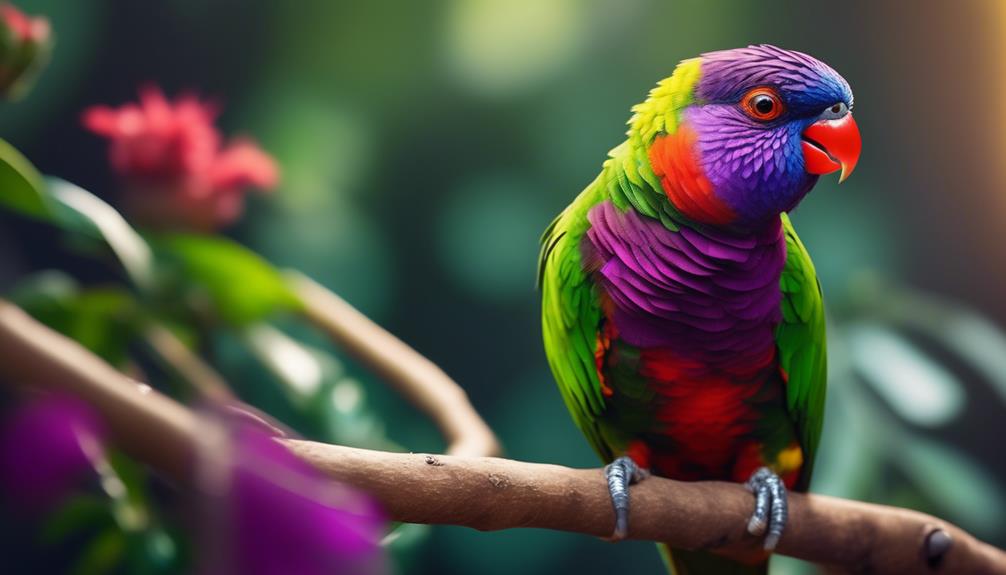
Now let's explore the lifespan and health of the Purple Crowned Lorikeet, a crucial aspect to consider when caring for these small and manageable birds.
The Purple Crowned Lorikeet has an average lifespan of 10 years. Proper care and interaction with people contribute to their health and happiness. Neglect can lead to health problems, so affection and socialization are important for their well-being.
It's important to provide them with a balanced diet consisting of nectar, fruits, vegetables, and commercial lorikeet food. Regular veterinary check-ups and vaccinations are also essential to ensure their continued good health. Additionally, providing them with a clean and spacious cage, regular exercise, and mental stimulation through toys and games will contribute to their overall well-being and longevity.
Bird Species and Physical Appearance
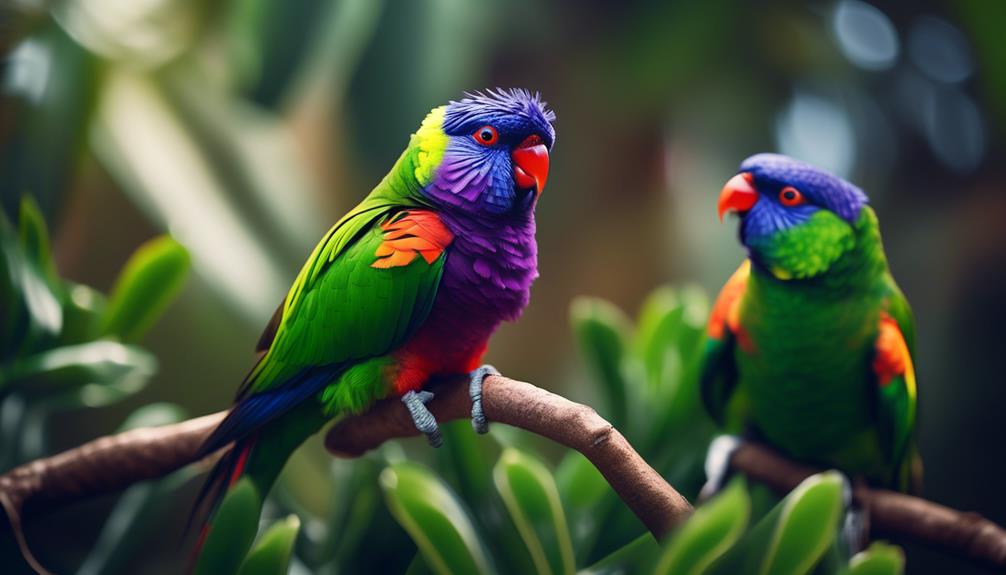
The Purple Crowned Lorikeet belongs to the Lory bird species, known for its large and diverse range. When it comes to physical appearance, this bird stands out in several ways:
- Resemblance to Fig Parrots and other small species: Unlike typical lorikeets, the Purple Crowned Lorikeet bears a closer resemblance to Fig Parrots and other small bird species.
- Unique physical features: They've a tiny, pointy beak and a short, tapered tail, giving them a distinct look.
- Striking colors: The Purple Crowned Lorikeet sports a vibrant appearance with bright colors. Its body is mostly light green with darker shades on the wings. The chest and belly are light, almost turquoise blue. The top of the head is dark purple with a fiery orange patch below it, and two circular patches on the cheek give it a cute, blushing look.
With their unique physical appearance, the Purple Crowned Lorikeets are sure to catch your eye.
Colors and Appearance
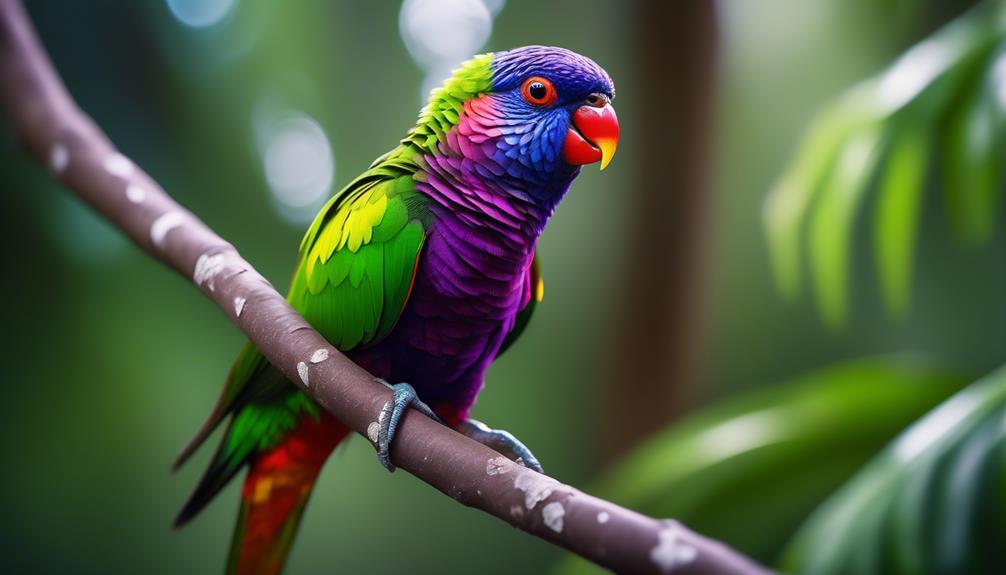
The Purple Crowned Lorikeet displays a striking appearance with its vibrant colors and unique physical features. Its body is mostly light green, with darker shades on the wings. The chest and belly are a light, almost turquoise blue. The top of the head is dark purple, with a fiery orange patch below it. Two circular patches on the cheeks give them a cute, blushing look.
The combination of these colors creates a vibrant and playful aesthetic that's truly eye-catching. In addition to its colors, the lorikeet also has a tiny, pointy beak and a short, tapered tail, adding to its distinctive appearance. Its overall appearance is a visual delight that makes this bird stand out in any setting.
Interaction and Socialization
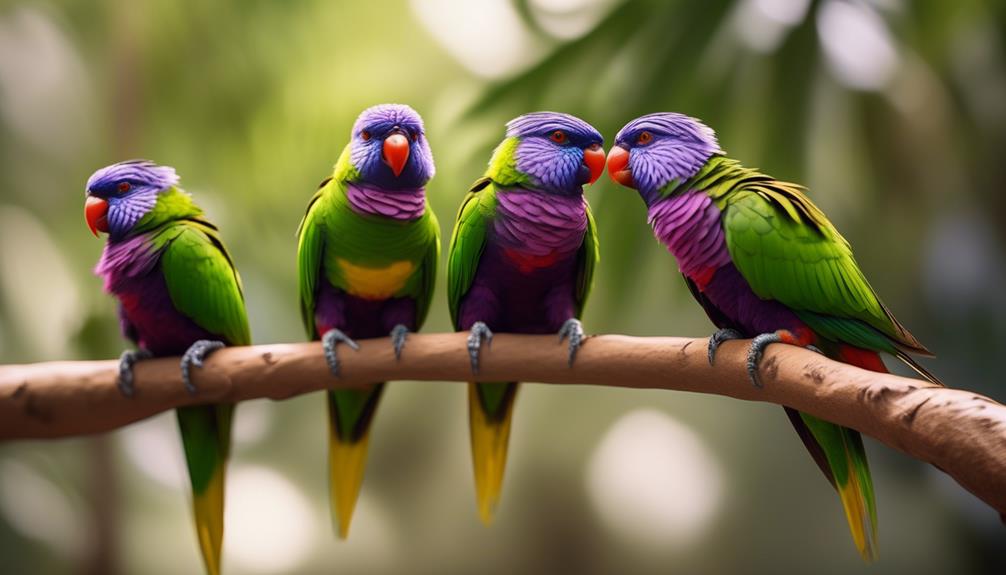
To build a strong bond with your Purple Crowned Lorikeet, regular interaction and socialization are key. Here are three important points to consider:
- Social Nature: Purple Crowned Lorikeets are social birds that thrive on companionship. They enjoy being around other birds of similar size and can even form strong bonds with their human caretakers. Interacting with them daily will help them feel loved and secure in their environment.
- Playful and Energetic: These lorikeets are known for their playful and energetic nature. They love flying around the house and exploring their surroundings. Providing them with plenty of toys and interactive activities will keep them entertained and mentally stimulated.
- Preventing Loneliness: Keeping Purple Crowned Lorikeets in pairs is highly recommended to prevent loneliness and boredom. Having a companion of their own kind will provide them with emotional support and reduce stress. It's important to ensure that they've enough space and resources to coexist harmoniously.
Habitat and Cage Requirements
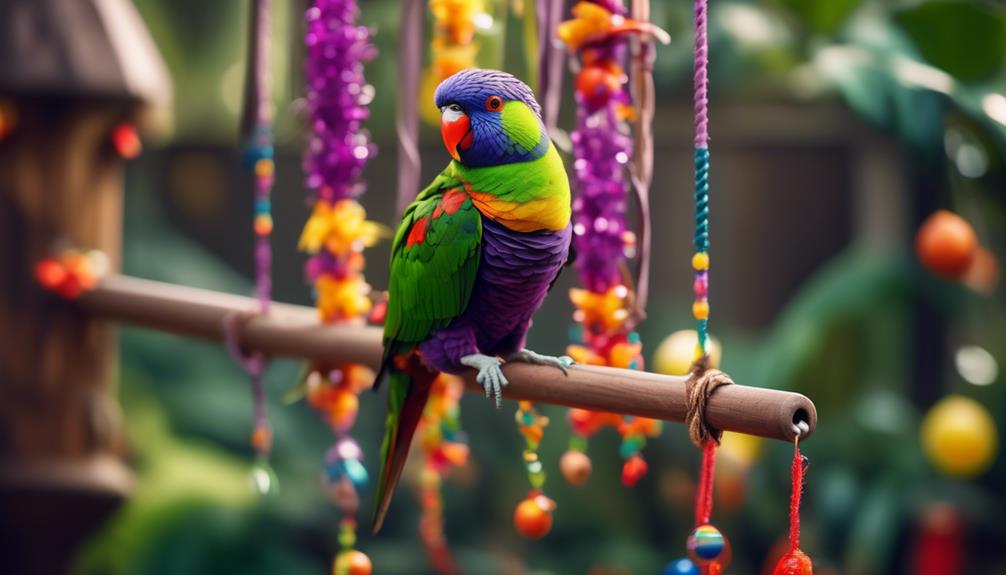
Regular interaction and socialization are key to building a strong bond with your Purple Crowned Lorikeet.
Now let's dive into their habitat and cage requirements.
Purple Crowned Lorikeets are smaller than most lorikeet breeds, measuring about 6 inches long and weighing 2 ounces. This makes them easy to accommodate as they can comfortably reside in an average-sized cage.
It's important to provide them with enough space to move around and stretch their wings. Additionally, ensure the cage has perches and toys for mental stimulation and physical exercise.
Remember to clean the cage regularly to maintain a clean and healthy environment for your lorikeet.
Diet and Feeding Habits
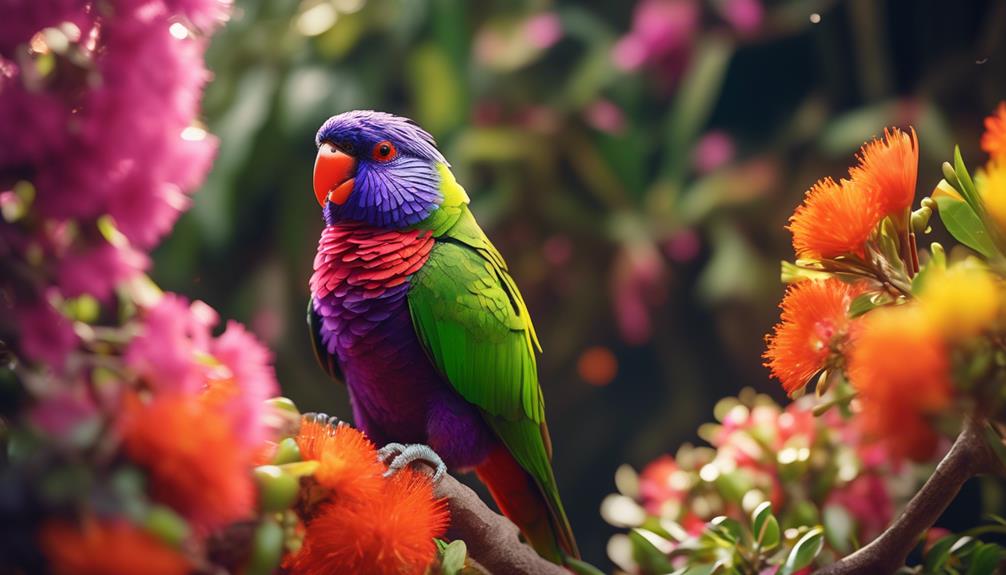
For optimal health and nutrition, it's important to understand the diet and feeding habits of your Purple Crowned Lorikeet. Here are some key points to keep in mind:
- Nectar and Pollen: These birds have a specialized brush-like tongue that allows them to extract nectar and pollen from flowers. Providing a commercial nectar mix is crucial for their well-being.
- Fruits and Vegetables: Along with nectar, a variety of fresh fruits and vegetables should be included in their diet. Offer them options such as apples, grapes, carrots, and leafy greens for a balanced meal.
- Protein Sources: To meet their protein needs, incorporate sources like cooked chicken, boiled eggs, and mealworms into their diet. These will help them maintain strong muscles and a healthy immune system.
Vocalization and Communication
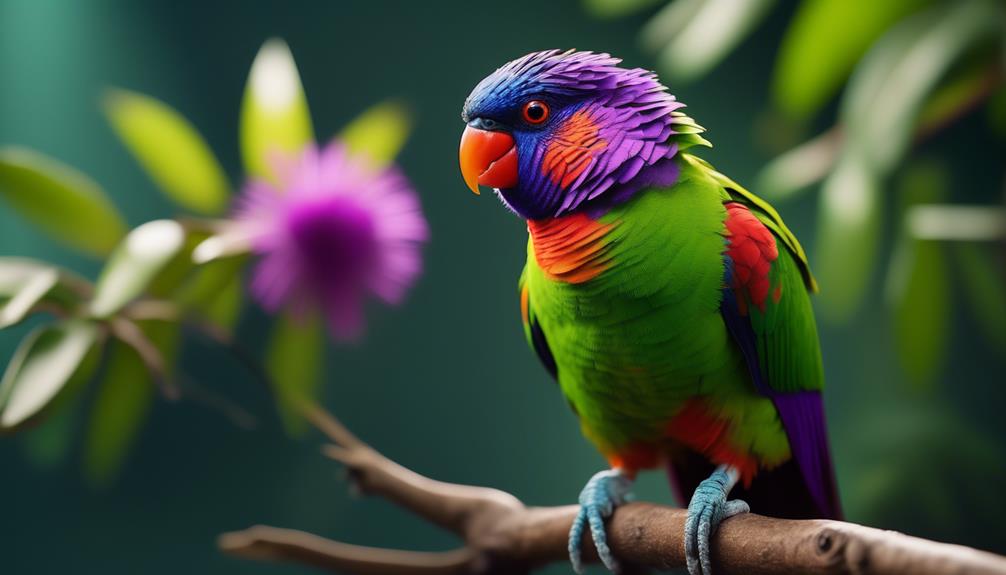
Purple Crowned Lorikeets have a unique way of vocalizing and communicating with their owners. They are known for their playful and vibrant personalities, which are reflected in their vocalizations. Here is a table that breaks down the different sounds they make and what they mean:
| Vocalization | Meaning |
|---|---|
| Chattering | Contentment and relaxation |
| Whistling | Excitement or calling out to their owner |
| Squawking | Warning or expressing discomfort |
| Purring | Happiness and affection |
| Mimicking | Imitating sounds or words they hear |
Breeding and Reproduction
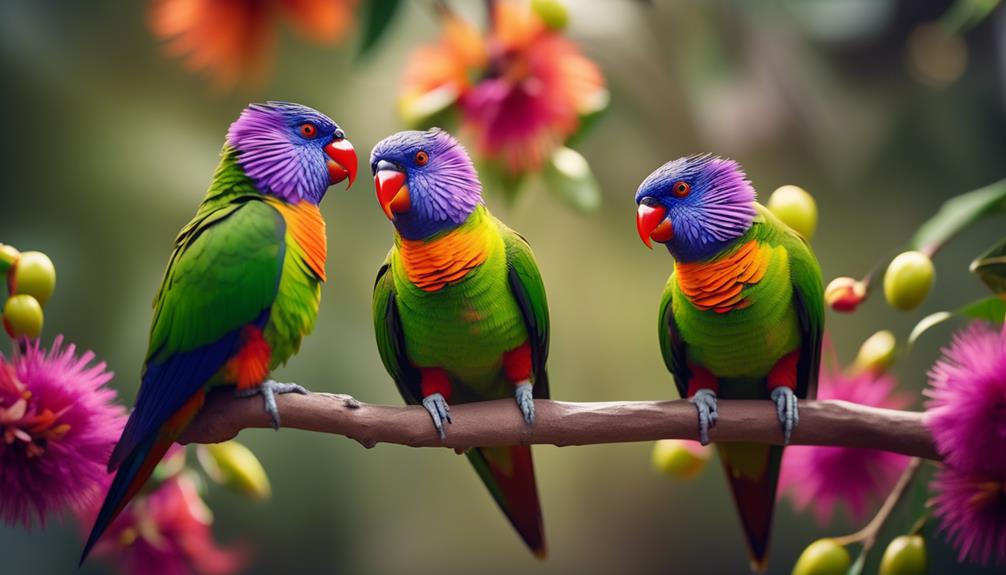
When it comes to breeding and reproduction, the Purple Crowned Lorikeet exhibits distinct behaviors and characteristics. Here are some key points to grab your attention:
- Breeding Season: These lorikeets breed during the wet season when food sources are abundant.
- Courtship Display: Males perform impressive acrobatic displays, including hanging upside down and fluttering their wings, to attract females.
- Monogamous Pairing: Once a pair is formed, they remain monogamous throughout the breeding season.
- Nesting Habits: They build their nests in tree hollows, using leaves, twigs, and feathers as materials.
- Egg Incubation: The female lays 1-2 eggs, and both parents take turns incubating them for about 23-26 days.
- Chick Care: Both parents actively participate in feeding and caring for the chicks until they fledge at around 8-10 weeks old.
- Breeding Success: With proper care and a suitable environment, Purple Crowned Lorikeets can successfully breed and raise healthy offspring.
Understanding these aspects of breeding and reproduction can help enthusiasts provide optimal conditions for these vibrant lorikeets.
Training and Enrichment
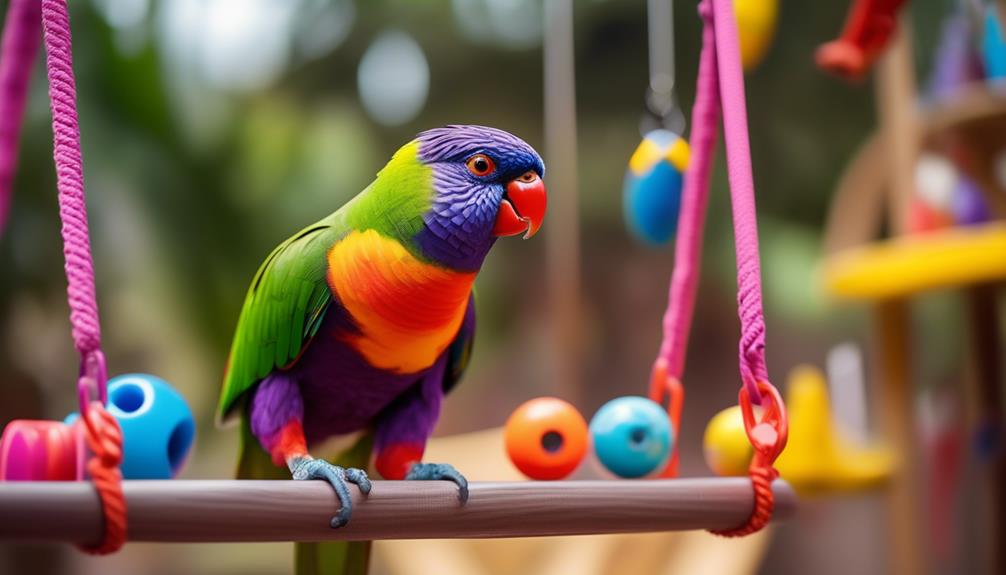
To ensure the well-being and development of your Purple Crowned Lorikeet, it is essential to focus on their training and enrichment. These intelligent and playful birds thrive when provided with mental stimulation and opportunities to learn new skills. Training your lorikeet not only strengthens your bond but also helps prevent behavioral issues. Enrichment activities, such as puzzle toys, foraging opportunities, and interactive playtime, keep them engaged and prevent boredom. Consider incorporating the following training and enrichment ideas into your routine:
| Training and Enrichment Ideas | Benefits | Tips for Implementation |
|---|---|---|
| Target Training | Improves focus and coordination | Use a clicker for positive reinforcement |
| Flight Training | Enhances physical fitness | Gradually increase flight distances |
| Teaching Tricks | Stimulates mental agility | Start with simple tricks and reward progress |
Common Health Issues
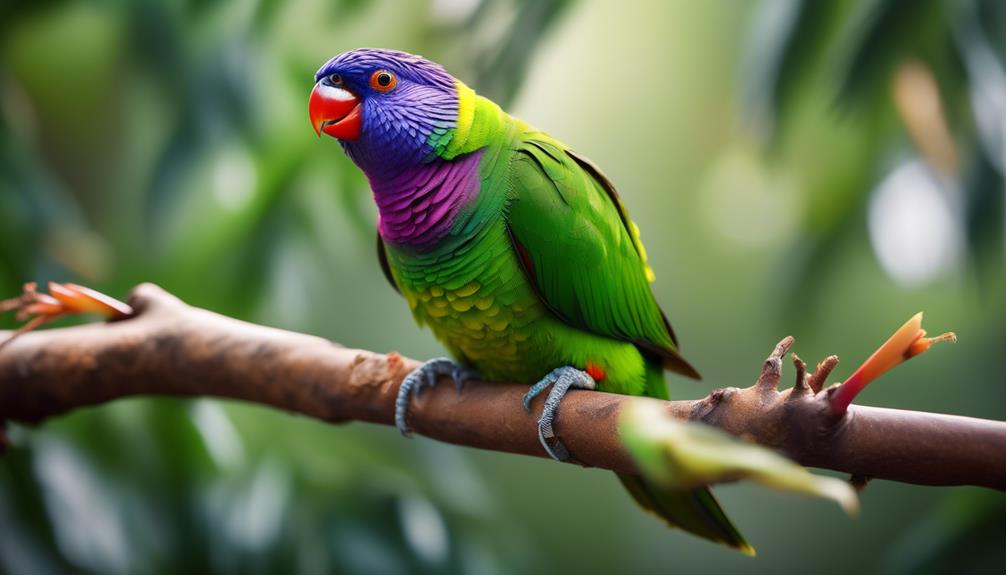
One important aspect of caring for your Purple Crowned Lorikeet is being aware of common health issues they may face. Here are some key health concerns to keep in mind:
- Nutritional deficiencies: Lorikeets have specialized dietary needs, so it's crucial to provide them with a balanced and varied diet to avoid deficiencies in vitamins, minerals, and amino acids.
- Feather plucking: This behavior can be a sign of stress, boredom, or underlying health problems. Regular interaction and environmental enrichment can help prevent feather plucking.
- Respiratory infections: Lorikeets are susceptible to respiratory infections, especially in poorly ventilated or damp environments. Maintaining a clean and dry living space, avoiding drafts, and providing fresh air are essential for their respiratory health.
Tips for Bonding With Your Lorikeet
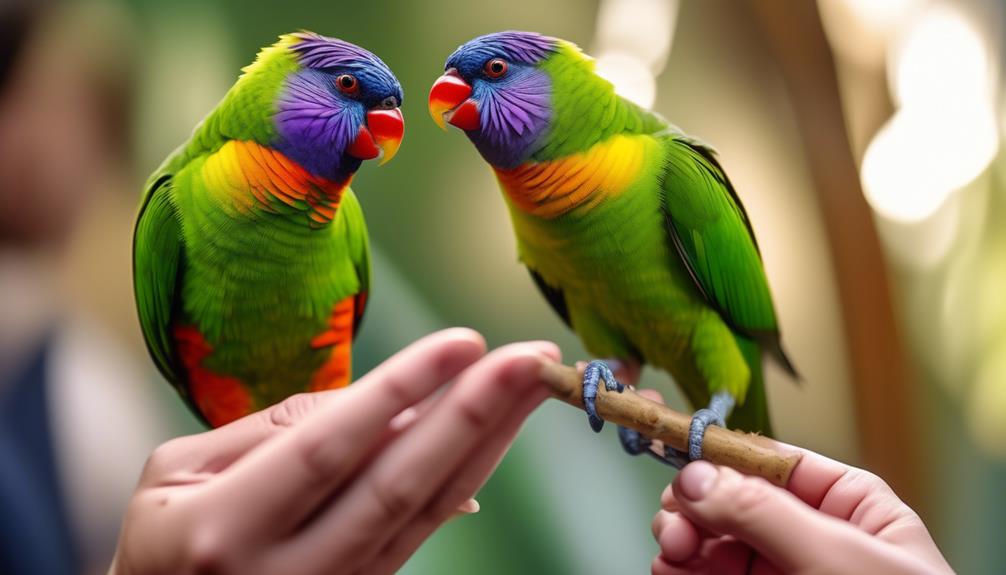
To establish a strong bond with your Purple Crowned Lorikeet, engage in daily interactive activities and provide them with affectionate care. Interacting with your lorikeet on a regular basis will help build trust and create a deeper connection. Here are some tips to help you bond with your feathered friend:
| Tip | Description | Benefits |
|---|---|---|
| Spend quality time | Dedicate daily time for one-on-one interaction, such as talking, singing, or playing games with your lorikeet. | Creates a sense of companionship and strengthens the bond |
| Offer treats | Use their favorite treats as rewards during training sessions. | Positive reinforcement enhances trust and cooperation |
| Provide a stimulating environment | Offer toys, puzzles, and foraging opportunities to keep your lorikeet mentally and physically active. | Prevents boredom and encourages engagement |
| Respect their boundaries | Allow your lorikeet to approach you at their own pace. | Builds confidence and reduces stress |
| Show love and affection | Gently stroke their feathers or give them head scratches to express your affection. | Establishes a sense of security and comfort |
Playful Behaviors and Toys
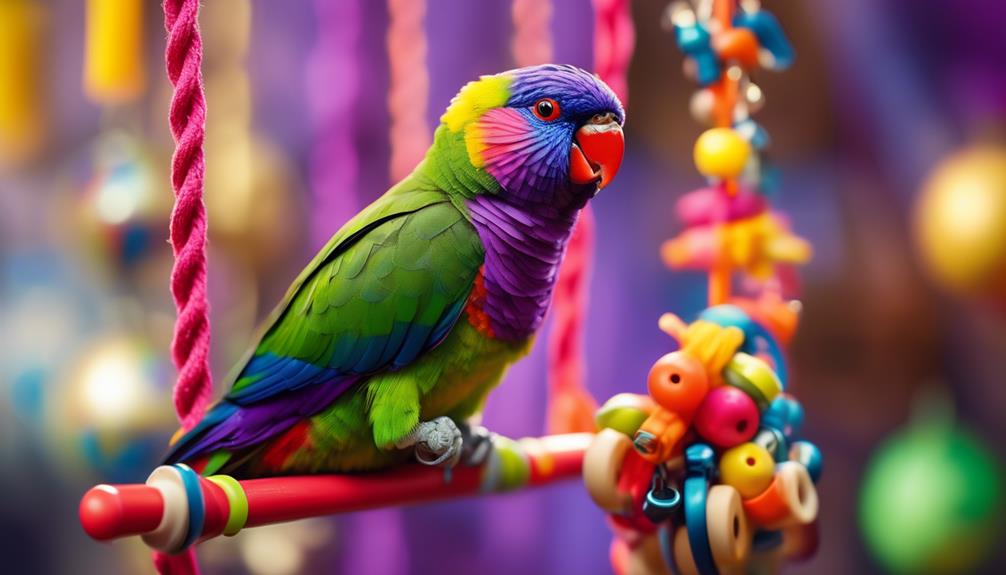
As you continue to build a strong bond with your Purple Crowned Lorikeet, let's explore their playful behaviors and the toys that can keep them entertained.
- Playful Behaviors:
- Purple Crowned Lorikeets are known for their energetic and playful nature.
- They love to climb, swing, and explore their surroundings.
- They enjoy engaging in interactive games with their owners, such as hide-and-seek or fetch.
- Toys for Entertainment:
- Provide a variety of toys to keep them mentally stimulated and physically active.
- Toys that encourage foraging, such as puzzle feeders or treat-dispensing toys, can keep them engaged.
- Swings, ladders, and ropes are great additions to their cage for climbing and swinging fun.
Handling and Care
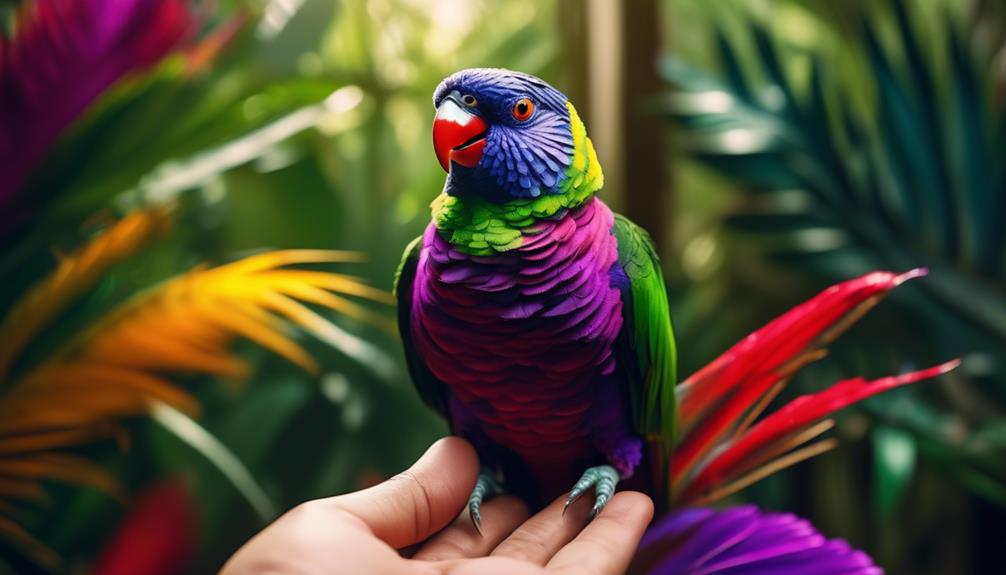
When handling and caring for your Purple Crowned Lorikeet, it's important to be gentle and attentive to their needs. These birds are small and delicate, so it's crucial to handle them with care. Always approach them slowly and avoid sudden movements that might startle them. When picking up your lorikeet, support their body with both hands and be mindful of their fragile wings.
Additionally, make sure to provide them with a proper diet consisting of fresh fruits, nectar, and pellets specifically formulated for lorikeets. Keep their cage clean and provide plenty of toys and perches for them to play and exercise.
Regular interaction and socialization are crucial for their well-being, so spend time with them and show them affection. By providing the necessary care and attention, your Purple Crowned Lorikeet will thrive and bring joy to your life.
Fun Facts and Trivia
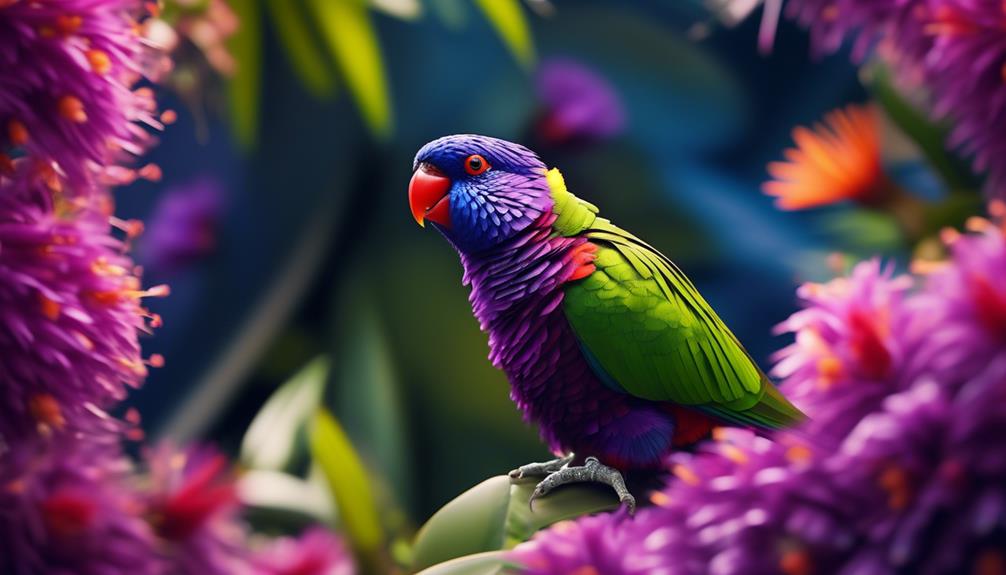
Did you know that Purple Crowned Lorikeets are known for their playful and energetic nature? These vibrant birds have some fascinating fun facts and trivia that you might find interesting:
- Unique Feeding Habits: Purple Crowned Lorikeets have a specialized brush-like tongue that allows them to feed on nectar and pollen from flowers. They also enjoy eating fruits, seeds, and insects.
- Acrobatic Flyers: These lorikeets are excellent aerial acrobats. They love to fly around, perform flips, and show off their agility in the air.
- Mimicking Skills: Purple Crowned Lorikeets have the ability to mimic sounds, including human speech. With a bit of training, they can even learn to repeat words or phrases.
Frequently Asked Questions
What Is the Average Lifespan of a Purple Crowned Lorikeet?
The average lifespan of a Purple Crowned Lorikeet is 10 years. Proper care and interaction with people are crucial for their health and happiness. Neglect can lead to health problems, so affection and socialization are important.
How Do Purple Crowned Lorikeets Communicate With Each Other?
Purple Crowned Lorikeets communicate with each other through various vocalizations, including chirps, whistles, and squawks. They also use body language, such as head bobbing and wing flapping, to express their emotions and intentions.
Can Purple Crowned Lorikeets Be Trained to Do Tricks?
Yes, purple crowned lorikeets can be trained to do tricks. With patience and positive reinforcement, you can teach them to perform various tricks like stepping up, flying to your hand, and even retrieving small objects.
Do Purple Crowned Lorikeets Have Any Unique Behaviors or Habits?
Purple Crowned Lorikeets have unique behaviors and habits. They are known for being social, shy, friendly, energetic, and playful. They enjoy flying around, playing with toys, and do well in pairs to prevent loneliness and boredom.
Are There Any Interesting Facts or Trivia About Purple Crowned Lorikeets?
There are many interesting facts about Purple Crowned Lorikeets! They belong to the Lory bird species and have a striking appearance with bright colors. They are social, playful, and enjoy flying and playing with toys.
What Makes the Purple Crowned Lorikeet Different from Rüppell’s Parrot?
The Purple Crowned Lorikeet and Rüppell’s Parrot are two distinct species in the fascinating world of Rüppell’s parrot. While both are beautiful birds with vibrant plumage, the Purple Crowned Lorikeet is known for its distinctive purple crown, while Rüppell’s Parrot showcases unique green and yellow coloring.
Conclusion
In conclusion, the Purple Crowned Lorikeet is a vibrant and playful bird that can bring color and excitement into your life. With their small size and average lifespan of 10 years, they're easy to accommodate and care for.
Their unique physical appearance, with striking colors, makes them truly eye-catching. Remember, affection and socialization are key to their well-being, so make sure to provide them with proper care and interaction.
Get ready to be captivated by the vibrancy and playfulness of the Purple Crowned Lorikeet!


